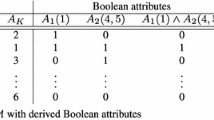Abstract
In this work, we present the hierarchical object-driven action rules; a hybrid action rule extraction approach that combines key elements from both the classical action rule mining approach, first proposed by Raś and Wieczorkowska (2000), and the more recent object-driven action rule extraction approach proposed by Hajja et al. (2012, 2013), to extract action rules from object-driven information systems. Action rules, as defined in Raś and Wieczorkowska (2000), are actionable tasks that describe possible transitions of instances from one state to another with respect to a distinguished attribute, called the decision attribute. Recently, a new specialized case of action rules, namely object-driven action rules, has been introduced by Hajja et al. (2012, 2013). Object-driven action rules are action rules that are extracted from information systems with temporal and object-based nature. By object-driven information systems, we mean systems that contain multiple observations for each object, in which objects are determined by an attribute that assumingly defines some unique distribution; and by temporally-based information systems, we refer to systems in which each instance is attached to a timestamp that, by definition, must have an intrinsic meaning for each corresponding instance. Though the notion of object-driven and temporal-based action rules had its own successes, some argue that the essence of object-driven assumptions, which is in big part the reason for its effectiveness, are imposing few limitations as well. Object-driven approaches treat entire systems as multi-subsystems for which action rules are extracted from; as a result, more accurate and specific action rules are extracted. However, by doing so, our diverseness of the extracted action rules are much less apparent, compared to the outcome when applying the classical action rule extraction approach, which treats information systems as a whole. For that reason, we propose a hybrid approach which builds a hierarchy of clusters of subsystems; a novel way of clustering through treatments responses similarities is introduced.



Similar content being viewed by others
References
Agrawal, R., Imieliski, T., Swami, A. (1993). Mining association rules between sets of items in large databases. In Proceedings of the 1993 ACM SIGMOD international conference on Management of data (SIGMOD ’93), P. Buneman and S. Jajodia (Eds.), ACM, New York, USA, 207–216. doi:10.1145/170035.170072.
Bazan, J., & Szczuka, M. (2005). The rough set exploration system. In Transactions on Rough Sets III, pp 25–42.
Gubrynowicz, R., Chojnacka-Wa̧dołowska, D., Konopka, C. (2007). Assessment of velum malfunction in children through simultaneous nasal and oral acoustic signals measurements. Archives of Acoustics, 32(1), 165–175.
Hajja, A., Wieczorkowska, A., Raś, Z.W., Gubrynowicz, R. (2012). Object-driven action rules and their application to hypernasality treatment. In Proceedings of ECML-PKDD workshop on new frontier in mining complex patterns, Bristol, September 24–28, 2012, 104–115.
Hajja, A., Wieczorkowska, A., Raś, Z.W., Gubrynowicz, R. (2013). Pair-based object-driven action rules. Post-proceedings of the first ECML/PKDD 2012 international workshop on new frontiers in mining complex patterns. LNAI 7765, Springer.
Pawlak, Z. (1981). Information systems - theoretical foundations. Information Systems Journal, 6, 205–218.
Raś, Z.W., & Wieczorkowska, A. (2010). Advances in music information retrieval, studies in computational intelligence. (Vol. 274). Springer.
Raś, Z.W., & Wieczorkowska, A. (2000). Action-Rules: How to increase profit of a company. In Zighed, D.A., Komorowski, J., Zytkow, J. (Eds.), PKDD 2000. LNAI (Vol. 1910, pp. 587–592). Heidelberg: Springer.
Raś, Z.W., & Dardzinska, A. (2011). From Data to Classification Rules and Actions. In the Special Issue on Rough Sets. Theory and Applications. In C.-C. Chan et al. (Ed.), International Journal of Intelligent Systems (Vol. 26(6), pp. 572–590). Wiley.
Raś, Z.W., Tzacheva, A., Tsay, L.S., Gürdal, O. (2005). Mining for interesting action rules. In Proceedings of IEEE/WIC/ACM international conference on intelligent agent technology (IAT 2005), IEEE Computer Society, 187–193.
Raś, Z.W., Dardzińska, A., Tsay, L.S., Wasyluk, H. (2008). Association action rules. In IEEE International conference on data mining workshops, 283–290.
Raś, Z.W., Wyrzykowska, E., Wasyluk, H. (2008). Action rules discovery based on agglomerative strategy. In Mining complex data, post-proceedings of 2007 ECML/PKDD third international workshop (MCD 2007), LNAI, Vol. 4944, 196–208, Springer.
SAMPA - computer readable phonetic alphabet. http://www.phon.ucl.ac.uk/home/sampa/.
Tsay, L.S., & Raś, Z.W. (2006). Action rules discovery system DEAR3. In Foundations of intelligent systems, Proceeding of ISMIS 2006, LNAI, Vol. 4203, 483–492, Springer.
Zhang, X., Raś Z.W., Jastreboff, P.J., Thompson, P.L. (2010). From Tinnitus data to action rules and tinnitus treatment. In Proceedings of 2010 IEEE conference on granular computing. Silicon Valley, IEEE Computer Society, 620–625.
Acknowledgments
The authors would like to thank Dr. Danuta Chojnacka-Wa̧dołowska and Dr. Cecylia Konopka, both from Children’s Memorial Health Institute in Warsaw; and Dr. Ryszard Gubrynowicz from PJIIT, for their help with data collection and providing medical diagnoses.
This project was partially supported by the Research Center of PJIIT, supported by the Polish Ministry of Science and Higher Education. It is also based upon work supported by the National Science Foundation under Grant No. OISE-0730065.
Author information
Authors and Affiliations
Corresponding author
Rights and permissions
About this article
Cite this article
Hajja, A., Raś, Z.W. & Wieczorkowska, A.A. Hierarchical object-driven action rules. J Intell Inf Syst 42, 207–232 (2014). https://doi.org/10.1007/s10844-013-0291-2
Received:
Revised:
Accepted:
Published:
Issue Date:
DOI: https://doi.org/10.1007/s10844-013-0291-2




